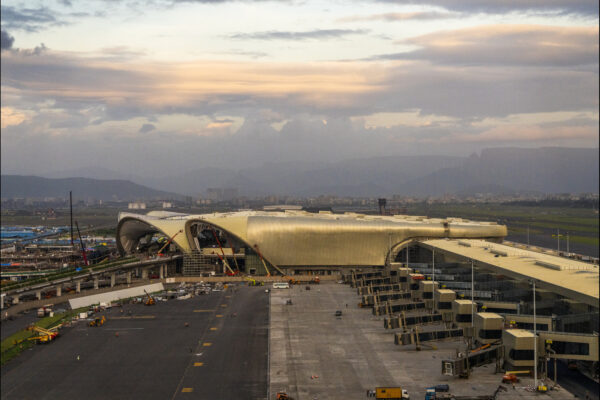Bridging India’s Infrastructure Funding Gap: How ECA and ECB Financing can support the country’s infrastructure push
by Shivdutt Das, Managing Director, Vishwa Samudra Holdings
With India aiming to become a developed country by 2047, upgrading the country’s road network, airports and railways along with an expansion in its domestic infrastructure capabilities has assumed chief importance. Towards this end, the Indian government has earmarked ₹11.21trillion of capital expenditure for the infrastructure sector in FY2025-26 alone, with further measures being envisioned to boost private sector participation in nation building efforts. The latter is especially relevant since private investments have been on the wane over the past fifteen years, largely due to the limited risk appetite of domestic financial institutions towards funding infrastructure development projects. In fact, the share of India’s private sector in total infrastructure-related investments has fallen from 46.4% between 2009-13 to a mere 7.2% between 2019-23. This not only underscores the importance of reviving private investments in domestic infrastructure projects, but also puts the spotlight on external funding options that could empower private firms to wholeheartedly participate in modernizing India’s infrastructure.
Exploring the world of external financing options
Despite limitations in domestic financing options, Indian private sector firms have made investment announcements amounting to ₹32.01 lakh crore in the April-December 2025 period. This amounts to nearly 70% of the total investment announcements and reflects the resurgence of private sector activity in India’s infrastructure push. To support this increased investment activity, Indian companies are raising capital through External Commercial Borrowings (ECBs) as well as securing loans or guarantees from Export Credit Agencies (ECAs). While ECBs are issued by foreign banks and financial institutions, ECA loans are usually provided by government-backed institutions to support exports from their own countries. Depending on the financing structure employed, the capital can be provided in the form of buyer or supplier credit, intermediary loans to a local bank or direct loans which is often the case with sovereign projects. These external borrowings can be deployed for financing large-scale infrastructure projects or used to fulfil short-term working capital requirements, making them indispensable for Indian firms that are playing a crucial role in fortifying India’s credentials as a manufacturing & export hub. Alternatively, Indian companies and banks can also obtain insurance from ECAs against commercial and geopolitical risks; thereby making them ideal to secure Indian interests in an increasingly globalised economic landscape.
How ECA & ECB loans can benefit private infrastructure firms
As on September 2024, Indian private companies accounted for $97.58 billion or 63% of the total foreign currency denominated and non-FDI components of ECBs that stood at approximately $154.9 billion. While these numbers have caused significant consternation due to concerns of a growing reliance on external debt, it has led to lower WACC (Weighted Average Cost of Capital) for Indian companies while also helping them diversify their financial borrowing mix. Moreover, private firms have been increasingly protecting themselves against currency fluctuations, with 74% of their total outstanding ECBs being hedged as on Q2FY2024-25.
For infrastructure players, external borrowings through the ECB/ECA route can unlock several benefits including lower interest rates, longer loan tenures and improved access to world-class technologies and suppliers. These aspects can go a long way towards improving project viability while also attracting foreign infrastructure firms to collaborate with domestic players on large-scale projects of strategic national importance. This is especially relevant for projects that involve the import of capital goods and large-scale technology transfer; making external borrowings the most optimum funding option for firms undertaking such ventures. Consequently, projects aimed at upgrading India’s urban infrastructure, transportation networks and even those aimed at enhancing India’s renewable energy capacity are witnessing a strong demand for overseas funding.
Mitigating risks intrinsic to external borrowings
As is the case with any form of external borrowing, companies need to understand the challenges involved and take sufficient measures to protect against inherent risks. For example, stringent documentation and compliance requirements can often result in long approval times ranging between 6-18 months, with additional bank guarantee requirements further straining available finances. What’s more, borrowing entities need to contend with insurance premiums, legal/consulting charges and arrangement fees that ought to be considered when calculating the overall cost of capital.
For firms opting for ECA loans, there is the added constraint of sourcing goods, services or even a technology partner from the foreign country where the loans originate. While this may suit projects where India currently lacks the relevant expertise or vendor base needed for timely execution, it could increase procurement costs and limit domestic manufacturing contribution for other infrastructure undertakings. Additionally, since most ECA/ECB loans are denominated in currencies such as the US dollar, Euro and Japanese Yen; it is imperative that borrowing firms hedge their total interest & principal exposure to avoid cost escalations arising due to depreciation in the Indian rupee.
Enhancing global investor participation and strategic collaborations
Recognizing the importance of garnering foreign capital inflows to aid in infrastructure development, the Indian government introduced 100% FDI under the automatic route for most sectors back in October 2020. As a result, more than 90% of current FDI inflows are being received through the automatic route, with prior approval being necessary only for sensitive projects and those cases where the prescribed parameters are not being met. Moreover, with ~68% of the total outstanding ECBs being hedged as of Q2FY2024-25 as compared with ~55% in FY2022-23, concerns about contagion risks arising due to currency fluctuations are being satisfactorily allayed by domestic borrowers.
While India has retained the title of the world’s fastest growing major economy for four successive years, it is estimated that an additional $2.2 trillion worth of infrastructure investment will be needed by 2030 to maintain the current growth momentum. Against this backdrop, the role of external borrowings in securing supplementary growth capital and coalescing international participation cannot be stressed enough. By raising ECBs and ECA loans, private infrastructure companies as well as central/state public sector undertakings (PSUs) can not only accelerate India’s infrastructure development, but also improve the country’s technological prowess through increased collaborations with infra-focused global firms. The combined effect should catapult India towards achieving a developed country status and drive never-seen-before levels of socio-economic progress over the coming decades.
Tags














